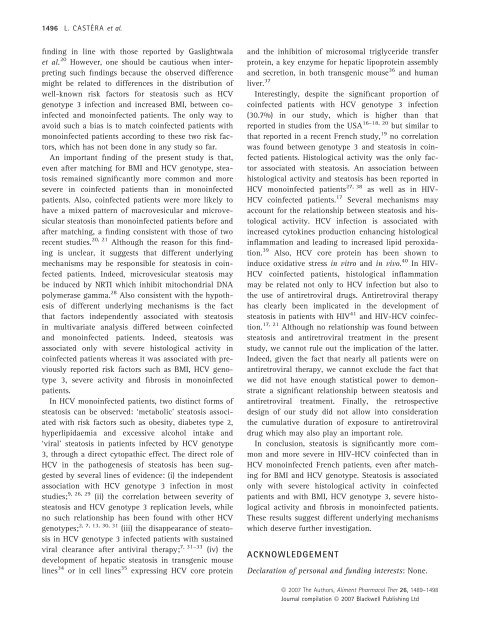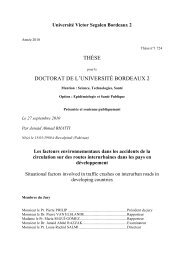Create successful ePaper yourself
Turn your PDF publications into a flip-book with our unique Google optimized e-Paper software.
1496 L. CASTÉRA et al.<br />
finding in line with those reported by Gaslightwala<br />
et al. 20 However, one should be cautious when interpreting<br />
such findings because the observed difference<br />
might be related to differences in the distribution of<br />
well-known risk factors for steatosis such as HCV<br />
genotype 3 infection and increased BMI, between coinfected<br />
and monoinfected patients. The only way to<br />
avoid such a bias is to match coinfected patients with<br />
monoinfected patients according to these two risk factors,<br />
which has not been done in any study so far.<br />
An important finding of the present study is that,<br />
even after matching for BMI and HCV genotype, steatosis<br />
remained significantly more common and more<br />
severe in coinfected patients than in monoinfected<br />
patients. Also, coinfected patients were more likely to<br />
have a mixed pattern of macrovesicular and microvesicular<br />
steatosis than monoinfected patients before and<br />
after matching, a finding consistent with those of two<br />
recent studies. 20, 21 Although the reason for this finding<br />
is unc<strong>le</strong>ar, it suggests that different underlying<br />
mechanisms may be responsib<strong>le</strong> for steatosis in coinfected<br />
patients. Indeed, microvesicular steatosis may<br />
be induced by NRTI which inhibit mitochondrial DNA<br />
polymerase gamma. 28 Also consistent with the hypothesis<br />
of different underlying mechanisms is the fact<br />
that factors independently associated with steatosis<br />
in multivariate analysis differed between coinfected<br />
and monoinfected patients. Indeed, steatosis was<br />
associated only with severe histological activity in<br />
coinfected patients whereas it was associated with previously<br />
reported risk factors such as BMI, HCV genotype<br />
3, severe activity and fibrosis in monoinfected<br />
patients.<br />
In HCV monoinfected patients, two distinct forms of<br />
steatosis can be observed: ‘metabolic’ steatosis associated<br />
with risk factors such as obesity, diabetes type 2,<br />
hyperlipidaemia and excessive alcohol intake and<br />
‘viral’ steatosis in patients infected by HCV genotype<br />
3, through a direct cytopathic effect. The direct ro<strong>le</strong> of<br />
HCV in the pathogenesis of steatosis has been suggested<br />
by several lines of evidence: (i) the independent<br />
association with HCV genotype 3 infection in most<br />
studies; 9, 26, 29 (ii) the correlation between severity of<br />
steatosis and HCV genotype 3 replication <strong>le</strong>vels, whi<strong>le</strong><br />
no such relationship has been found with other HCV<br />
genotypes; 2, 7, 13, 30, 31 (iii) the disappearance of steatosis<br />
in HCV genotype 3 infected patients with sustained<br />
viral c<strong>le</strong>arance after antiviral therapy; 7, 31–33 (iv) the<br />
development of hepatic steatosis in transgenic mouse<br />
lines 34 or in cell lines 35 expressing HCV core protein<br />
and the inhibition of microsomal triglyceride transfer<br />
protein, a key enzyme for hepatic lipoprotein assembly<br />
and secretion, in both transgenic mouse 36 and human<br />
liver. 37<br />
Interestingly, despite the significant proportion of<br />
coinfected patients with HCV genotype 3 infection<br />
(30.7%) in our study, which is higher than that<br />
reported in studies from the USA 16–18, 20 but similar to<br />
that reported in a recent French study, 19 no correlation<br />
was found between genotype 3 and steatosis in coinfected<br />
patients. Histological activity was the only factor<br />
associated with steatosis. An association between<br />
histological activity and steatosis has been reported in<br />
27, 38<br />
HCV monoinfected patients as well as in HIV-<br />
HCV coinfected patients. 17 Several mechanisms may<br />
account for the relationship between steatosis and histological<br />
activity. HCV infection is associated with<br />
increased cytokines production enhancing histological<br />
inflammation and <strong>le</strong>ading to increased lipid peroxidation.<br />
39 Also, HCV core protein has been shown to<br />
induce oxidative stress in vitro and in vivo. 40 In HIV-<br />
HCV coinfected patients, histological inflammation<br />
may be related not only to HCV infection but also to<br />
the use of antiretroviral drugs. Antiretroviral therapy<br />
has c<strong>le</strong>arly been implicated in the development of<br />
steatosis in patients with HIV 41 and HIV-HCV coinfection.<br />
17, 21 Although no relationship was found between<br />
steatosis and antiretroviral treatment in the present<br />
study, we cannot ru<strong>le</strong> out the implication of the latter.<br />
Indeed, given the fact that nearly all patients were on<br />
antiretroviral therapy, we cannot exclude the fact that<br />
we did not have enough statistical power to demonstrate<br />
a significant relationship between steatosis and<br />
antiretroviral treatment. Finally, the retrospective<br />
design of our study did not allow into consideration<br />
the cumulative duration of exposure to antiretroviral<br />
drug which may also play an important ro<strong>le</strong>.<br />
In conclusion, steatosis is significantly more common<br />
and more severe in HIV-HCV coinfected than in<br />
HCV monoinfected French patients, even after matching<br />
for BMI and HCV genotype. Steatosis is associated<br />
only with severe histological activity in coinfected<br />
patients and with BMI, HCV genotype 3, severe histological<br />
activity and fibrosis in monoinfected patients.<br />
These results suggest different underlying mechanisms<br />
which deserve further investigation.<br />
ACKNOWLEDGEMENT<br />
Declaration of personal and funding interests: None.<br />
ª 2007 The Authors, Aliment Pharmacol Ther 26, 1489–1498<br />
Journal compilation ª 2007 Blackwell Publishing Ltd
















